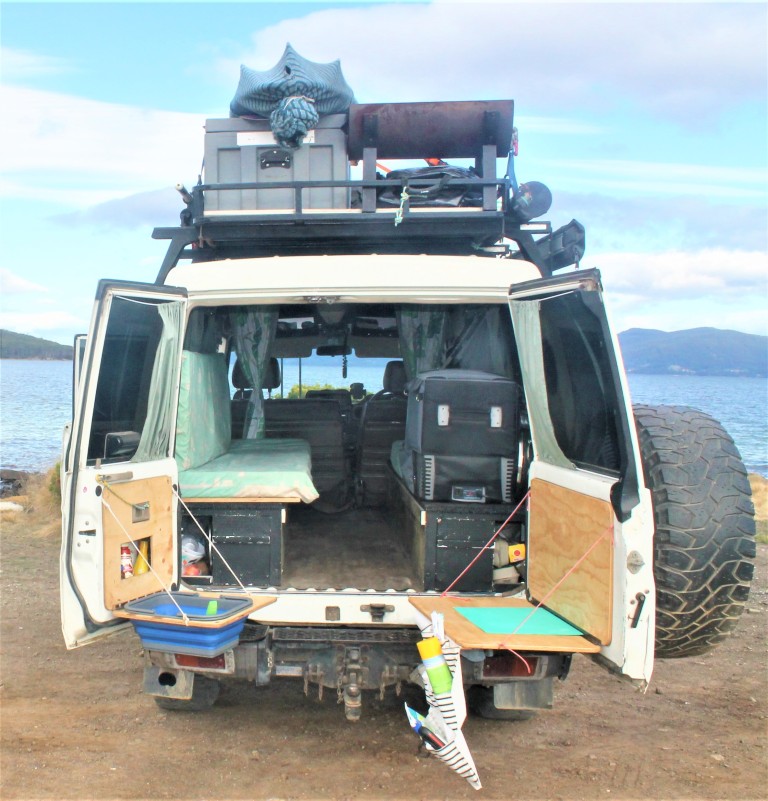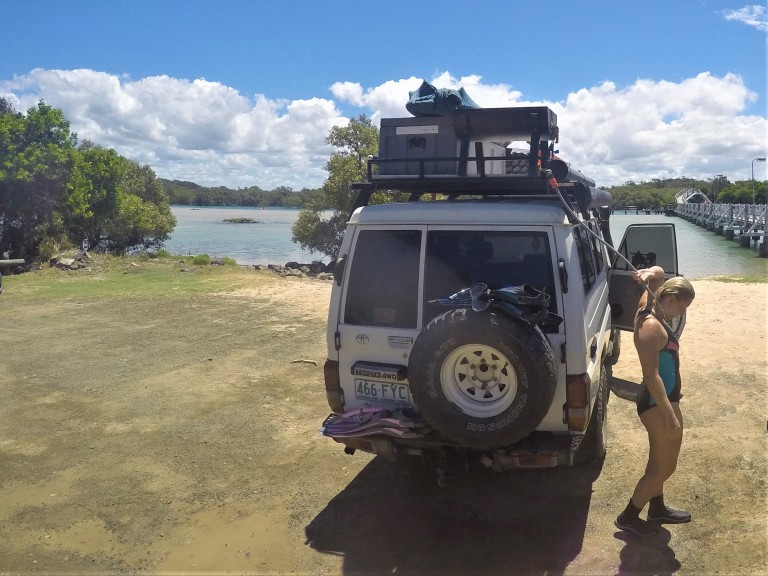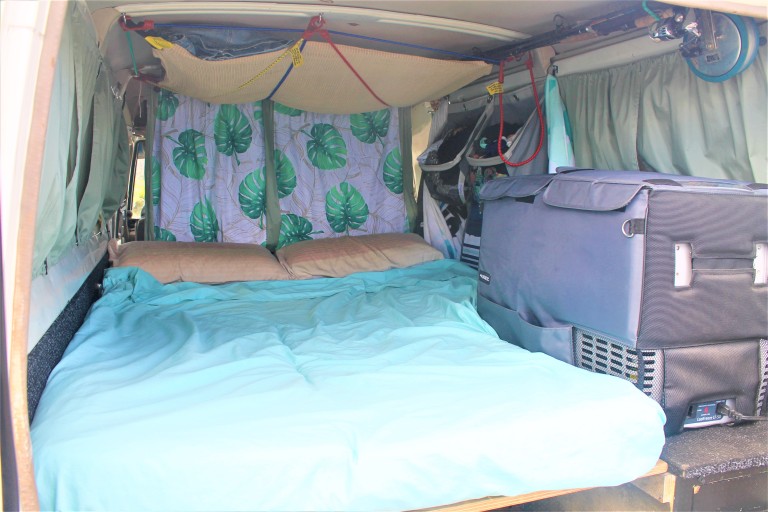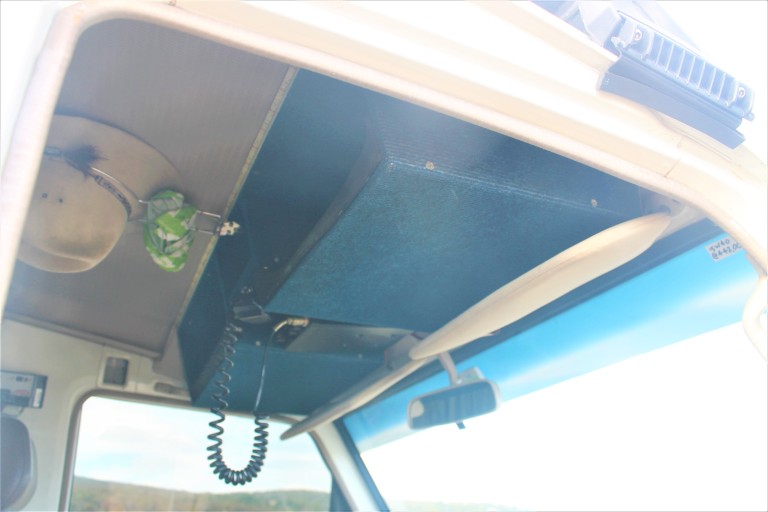After two months on the road we decided to give the Troopy a cleanout on Bruny Island. We are in love with our Troopy; we think it is the ideal touring vehicle. Thanks to the legends who owned her before us, we didn’t have to do too much to get her ready before leaving on the trip of a lifetime around Australia.
Our 1995 model 75 series Toyota Land Cruiser has a 4.2L 1HZ Diesel engine. It has duel fuel tanks with total 160 litre capacity, setup with duel batteries under the bonnet and has a solar panel on the roof to keep them charged up. We have approx 30L water storage around the roof racks + 45L (total) portable water containers. Custom rear draws/bed platform and a rear outdoor kitchen setup. Dark tinted windows, curtains on all rear windows as wells as large curtains to cut off the cab with flyscreens over the rear two side windows all giving us a bit of extra privacy. There is also a 3m x 3m side awning that rolls out for when we are looking for some shade on the beach or to keep out of the rain when we setup at camp.
For the majority of our trip the Troopy is used as our tow vehicle with a 16 foot pop top caravan trailing along behind so it is not going to break any land speed records, but it gets us where we have to go and we are in no real rush anyway. It is setup to be self-contained without the caravan and we have recently tested her out by leaving the van on mainland Australia while we made our way around Tasmania.
We are always interested in how people have setup their vehicles to tour Australia and below we run through some of the main talking points when it comes to comparing setups with other likeminded Aussie travellers.

12 VOLT POWER
We have a 120W Thunder solar panel on the roof that is connected to a Redarc Solar Regulator and Monitor which charges an auxiliary 97 Ah sealed Lead-Calcium battery under the bonnet. The duel battery setup means we can draw 12 Volt (V) power from the auxiliary battery and never have to worry about flattening the crank battery.
From the auxiliary battery we run a number of 12V appliance, pretty much everything except for the starter motor and headlights comes off the second battery.
- CF50 Waeco fridge – wired into an Anderson plug (standard cigarette lighter plug falls out)
- 2 x 10A 12V cigarette lighter output sockets for charge phones etc
- UHF radio
- ARB air compressor
- AM/FM Radio
- Internal LED strip lighting
Like all cars when it is running the alternator is putting power back into the batteries. There is a Redarc Smart Start SBI Battery Isolator under the bonnet which firstly prioritises re-charging the crank battery to 13.2 Volts then once it has reached that set voltage it begins charging the auxiliary battery while ensuring that a low charge in the secondary battery won’t drain the primary battery. 12 Volt setups can be costly and complicated or you can keep it simple, it all depends on what power you are looking to draw from your system and then determining how you will regenerate that power as to not flatten your auxiliary battery. I will try not to begin a lecture on 12 Volt as I am no way an expert and am continuing to learn but there are two types of people when it comes to 12V setups
- The people whose setup costs a small fortune and will run for ever in a day without needing to run your car to re-charge you batteries.
This means big batteries (sometimes more than one auxiliary battery) & big solar panels
- The people whose setups are in no way self sufficient but get them by doing what they need.
We are the second type in case you haven’t gathered. Essentially we can stay in one spot, running just the fridge, and the solar panel will keep the battery topped up if the skies are clear and sunny. If there is no sun for the solar panels, eventually after a couple of days the fridge will drain the auxiliary battery down to a point in which the fridge is programmed to cut off- Waeco have 3 different voltage cut off settings – High 11.8V, Medium 11.4 V, Low 10.1V – so with a duel battery setup we have found it is best to run the fridge on the Low setting to use the most out of the auxiliary battery. Remembering also that it’s not the end of the world if the fridge stops running, as long as you only open the fridge when you need it will stay cold for quite a while. The only time you need to panic is when the beers aren’t cold enough and all you need to do is go for a drive to charge up the battery again. Typically we are driving around every day or two anyway so we rarely have any issues.
We charge our phones, laptops, camera etc while driving getting the most out of the alternators power – this is something we have had to get in the habit of doing. We have a 150W Projecta inverter (about as small as you can get these days) that converts 12V DC to 240V AC power to charge our laptops, cameras & 18V Milwaukee power tool batteries – These are the only 240V appliances we have. We don’t try and run kettles or microwaves or other power hungry 240V appliances as firstly you would need a bigger more expensive inverter and secondly the inverters draw a lot of power from your batteries.
WATER
We run two portable water containers and have one tank fixed to the roof racks. The portable containers are 20L of filtered drinking water and 25L of tap water for washing & showering. Ideally we would have an under body water tank but we deal with what we have just fine. We purchased the blue 20L container for about $30 and picked up the clear 25L container out of a bin behind a fish and chip shop, it was previously a bulk container of washing detergent. The two portable containers can be laid down and fit under the bed, between the storage boxes. We filter the drinking water with an inline carbon filter that you can buy from hardware or camping stores and it removes chlorine & other odours from the water. For drinking water we have a number of stainless steel drink bottles that we rotate through the fridge and fill up from blue drinking water container.

There is also approx 30L of capacity around the roof racks in PVC pipe that has been painted black to heat the water from the sun during the day. This tank we use as an outdoor shower when the weather is nice and warm.

All up this water supply lasts us about 3-5 days depending on how much water we use for washing and showering as this is our biggest use. We use public facilities as much as possible for showering; a quick rinse in a beach cold water shower after a swim or if we are lucky enough to find a free hot shower this saves us from continuously having to fill up the water containers.
Finding a place to fill up the water containers can be simple in some suburbs and then seem impossible in others however we have a trick up our sleeves. Being a plumbers son, Dad has hooked us up with a tap key (if you haven’t heard of these defiantly click the link, you can pick them up from plumbing supplies or Bunnings) which works a treat turning on those taps that they don’t want you to turn on. To fill up the containers we have a length of potable water hose (using ordinary garden hose doesn’t taste that great), a short length cut for the filter and a long length for those “hard to get to places”.
STORAGE
When everything you need to live is packed into one vehicle adequate storage and organisation is vital. The most import thing is to only pack items that are absolutely necessary, this is easier said than done and we will get better.
The rear boxes in the back of the troopy were made by the previous owner out of aluminium frame with ply wood draws and lids, these boxes can be easily removed. The pictures will describe the construction better than I can word it. We use the 2 rear draws for food storage and the space beside the draws for other frequently used items. The front 2 compartments are used to store spare parts, tools, recovery equipment, drizabones and hiking boots as these are less frequently used. The two separate boxes means there is free space in the centre to walk down and we can use the passenger side box as a couch to sit up inside. A piece of ply fits between the two boxes to create a large level platform that is our bed. Rather than have one large mattress we have 3 separate pieces that gives us versatility with how we want the back setup. If we pull up for the night we typically pull out the water containers, our camp chairs, folding table and floor mat however if it is raining or we are doing a short stop we have the ability to store everything inside the car while still having the bed setup.
When we are not using the bed we store the pillows, sheets and the blanket in an over head cargo net that we made from shade sail material. The cargo net is also used to store our jumpers and other bulky clothing items and gets these items up out of the way – my brother gave us this great idea. When the cargo net is full it does reduce headspace in the back however it only takes up about the front 3rd of space just behind the cab which isn’t does get as much use. The cargo net has a second use of storing my fishing rods up and out of the way.


There is a storage box on the roof racks that holds our shower tent, 12v shower setup, portable toilet (yet to use), camp oven, opera house pots, jumper cables and some other rarely used items. On top of the box we have crab pots and a surfboard. The only other things we store on the roof racks are a second spare and a fire pit. A ladder to get up on the roof would be great but for now I just have to climb my way up and try not to have too many beers beforehand.
In the cab there is an overhead console unit that was already installed by previous owners and this works great for keeping personal items that are communally used up and out of the way while also easily accessible while on the road. Being a bench seat in the front we don’t have a centre console and the glove box is great at letting everything fall out when you open it so the over head consol is extremely handy. There is a box on the market that sits inside the glove box to stop everything falling out and we could also do with something over the overhead boxes so when we are off road everything doesn’t fall out on your head, all a working progress.

OUR OUTDOOR KITCHEN
The troopy already had a fold down table built into the large rear door which really works a treat, we just added a few modifications for storing kitchen utensils and it was good to go. We had taken some inspo from other troopy setups where they had used the rear barn door with a similar style fold down table with built in collapsible sink as cleaning up the dishing was a real pain without beforehand. While we had a day spare at Gippsland Lakes we wacked together the fold down sink setup as it turned out the collapsible sink we already had purchased earlier from Aldi was the perfect size. Other than the Aldi sink, everything else we picked up was from Bunnings, 12mm ply, 300mm long hinge, metal self tapping screws and a bit of rope. Using the original door trim as a template for the ply and also fitting up the hole in the back board with existing openings in the doors metal frame, we use this to store our condiments. The one thing we had to overcome was the fact that now when the sink was folded up it covered the rear barn door handle, a bit of telecom rope tied to the handle fixed this issue. We cook on a primus gas burner with disposable butain gas canisters, is in no way our ideal cooking appliance but we deal with it and one day will upgrade.
The gas cooker isn’t the only thing that we are looking to improve in our kitchen setup, firstly lighting and secondly shelter from the weather. Trying to get dinner cooked before it is pitch black is ideal but not always practical. We use the internal LED lighting in the troopy cap with headlights and torches which we make do with for the time being, some better work lighting LEDs are on the list of things to do. We have a wanderer 3m x 3m awning on the driver’s side but no cover over the back where the kitchen is. We have thought about buying an awning to come off the back but are not totally convinced it is the best solutions for stop the rain so for now we made do (when it rains) with a tarp over the doors and tied back to the roof racks – not a fun time cooking in the rain and wind.

THE CONS
Some things we have to make do with and that we will work on over time.
- Mirrors are rubbish but we deal with it by adding caravan mirrors and string line to bull bar. Hopefully Santa brings us a set of Clearview mirrors.
- External work lighting is something we will add over time
- Headlights are useless and need to be upgraded but we try to keep night driving to a minimum anyhow
- Spares tires are slightly different size to wheels and tires on the car. Running MT M/T-265/75/16 on car with 2 odd spares 15’ rims with 33’s.
- Rust… I just try not to look at it.
The one thing that we love about having a Land Cruiser is that each one you see is different in one way or another and everyone is happy to show you their setups and how they overcame their own problems. It is rare to see one stock without some kind of modification. They are conversation starters and we have made a number of friends along the way talking over our setup and our travels. The ingenuity is not limited to just Land cruiser owners; the entire camping and touring community is full of great unique ideas that people have developed to solve their own problems. In today’s market there are plenty of off the shelf products that have been copied off of what was at one point a back yard prototype, these homemade & engineered solutions are truly what makes the Australian camping and touring community special. Keep up the good work legends!
Zac












You need one of these Zac.
https://www.all4adventure.com/gear-spotlight-rhino-rack-batwing-awning/
LikeLike
There are a few different brands with the same idea on the market so we have been scoping them out along the way. When we have some $$$ we will get one for sure!
LikeLike
Looks like a pretty good setup you have there! Do you mostly sleep and cook based from the troopy? Or are you mostly doing everything out of the caravan?
The sink on the smaller rear door definitely looks like a great idea though, I may have to set that up on mine!
Rust is also something that can get pretty nasty on troopies! Hopefully your’s doesn’t get too out of hand 🙂
LikeLike
Gday Michael.
Thanks very much. Currently on this trip around AUS we spend most of our nights sleeping in and cooking from the van however we have done a number of stints in the Troopy leaving the van behind. These range from day trips down the beach or out on some 4WD track and fixing up some lunch out the back of the Troopy to 2 weeks in TAS without the van. We like having the Troopy setup total independent of our van setup so that at the drop of a hat we can shoot off anywhere remote and we have everything we need. The most important thing is that the beer is always kept cool in the waeco in the back of the Troopy!
We are in Exmouth now so will have to read up on you blog. We keep an eye out for you on the road.
LikeLike
Oh yeah sounds like a pretty good setup! Definitely sounds like an idea for when I can get around to buying a caravan or camper trailer 🙂
Haha, a camping trip without cold beers is never too fun! :p
Sounds awesome! Exmouth is definitely an amazing part of Australia, whereabouts are you heading from there?
LikeLike